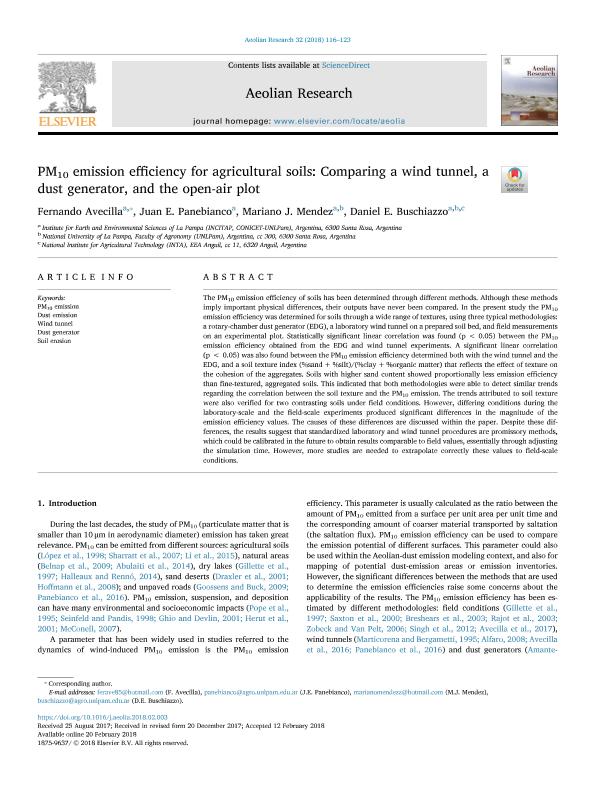Mostrar el registro sencillo del ítem
dc.contributor.author
Avecilla, Fernando

dc.contributor.author
Panebianco, Juan Esteban

dc.contributor.author
Mendez, Mariano Javier

dc.contributor.author
Buschiazzo, Daniel Eduardo

dc.date.available
2020-01-28T18:29:51Z
dc.date.issued
2018-06
dc.identifier.citation
Avecilla, Fernando; Panebianco, Juan Esteban; Mendez, Mariano Javier; Buschiazzo, Daniel Eduardo; PM10 emission efficiency for agricultural soils: Comparing a wind tunnel, a dust generator, and the open-air plot; Elsevier; Aeolian Research; 32; 6-2018; 116-123
dc.identifier.issn
1875-9637
dc.identifier.uri
http://hdl.handle.net/11336/96007
dc.description.abstract
The PM10 emission efficiency of soils has been determined through different methods. Although these methods imply important physical differences, their outputs have never been compared. In the present study the PM10 emission efficiency was determined for soils through a wide range of textures, using three typical methodologies: a rotary-chamber dust generator (EDG), a laboratory wind tunnel on a prepared soil bed, and field measurements on an experimental plot. Statistically significant linear correlation was found (p < 0.05) between the PM10 emission efficiency obtained from the EDG and wind tunnel experiments. A significant linear correlation (p < 0.05) was also found between the PM10 emission efficiency determined both with the wind tunnel and the EDG, and a soil texture index (%sand + %silt)/(%clay + %organic matter) that reflects the effect of texture on the cohesion of the aggregates. Soils with higher sand content showed proportionally less emission efficiency than fine-textured, aggregated soils. This indicated that both methodologies were able to detect similar trends regarding the correlation between the soil texture and the PM10 emission. The trends attributed to soil texture were also verified for two contrasting soils under field conditions. However, differing conditions during the laboratory-scale and the field-scale experiments produced significant differences in the magnitude of the emission efficiency values. The causes of these differences are discussed within the paper. Despite these differences, the results suggest that standardized laboratory and wind tunnel procedures are promissory methods, which could be calibrated in the future to obtain results comparable to field values, essentially through adjusting the simulation time. However, more studies are needed to extrapolate correctly these values to field-scale conditions.
dc.format
application/pdf
dc.language.iso
eng
dc.publisher
Elsevier

dc.rights
info:eu-repo/semantics/openAccess
dc.rights.uri
https://creativecommons.org/licenses/by-nc-sa/2.5/ar/
dc.subject
DUST EMISSION
dc.subject
DUST GENERATOR
dc.subject
PM10 EMISSION
dc.subject
SOIL EROSION
dc.subject
WIND TUNNEL
dc.subject.classification
Geociencias multidisciplinaria

dc.subject.classification
Ciencias de la Tierra y relacionadas con el Medio Ambiente

dc.subject.classification
CIENCIAS NATURALES Y EXACTAS

dc.title
PM10 emission efficiency for agricultural soils: Comparing a wind tunnel, a dust generator, and the open-air plot
dc.type
info:eu-repo/semantics/article
dc.type
info:ar-repo/semantics/artículo
dc.type
info:eu-repo/semantics/publishedVersion
dc.date.updated
2019-10-22T17:29:44Z
dc.journal.volume
32
dc.journal.pagination
116-123
dc.journal.pais
Países Bajos

dc.journal.ciudad
Amsterdam
dc.description.fil
Fil: Avecilla, Fernando. Consejo Nacional de Investigaciones Científicas y Técnicas. Instituto de Ciencias de la Tierra y Ambientales de La Pampa. Universidad Nacional de La Pampa. Facultad de Ciencias Exactas y Naturales. Instituto de Ciencias de la Tierra y Ambientales de La Pampa; Argentina
dc.description.fil
Fil: Panebianco, Juan Esteban. Consejo Nacional de Investigaciones Científicas y Técnicas. Instituto de Ciencias de la Tierra y Ambientales de La Pampa. Universidad Nacional de La Pampa. Facultad de Ciencias Exactas y Naturales. Instituto de Ciencias de la Tierra y Ambientales de La Pampa; Argentina
dc.description.fil
Fil: Mendez, Mariano Javier. Consejo Nacional de Investigaciones Científicas y Técnicas. Instituto de Ciencias de la Tierra y Ambientales de La Pampa. Universidad Nacional de La Pampa. Facultad de Ciencias Exactas y Naturales. Instituto de Ciencias de la Tierra y Ambientales de La Pampa; Argentina. Universidad Nacional de La Pampa. Facultad de Agronomía; Argentina
dc.description.fil
Fil: Buschiazzo, Daniel Eduardo. Instituto Nacional de Tecnología Agropecuaria. Centro Regional La Pampa-San Luis. Estación Experimental Agropecuaria Anguil; Argentina. Universidad Nacional de La Pampa. Facultad de Agronomía; Argentina. Consejo Nacional de Investigaciones Científicas y Técnicas. Instituto de Ciencias de la Tierra y Ambientales de La Pampa. Universidad Nacional de La Pampa. Facultad de Ciencias Exactas y Naturales. Instituto de Ciencias de la Tierra y Ambientales de La Pampa; Argentina
dc.journal.title
Aeolian Research
dc.relation.alternativeid
info:eu-repo/semantics/altIdentifier/url/https://www.sciencedirect.com/science/article/pii/S1875963717301660
dc.relation.alternativeid
info:eu-repo/semantics/altIdentifier/doi/https://doi.org/10.1016/j.aeolia.2018.02.003
Archivos asociados
